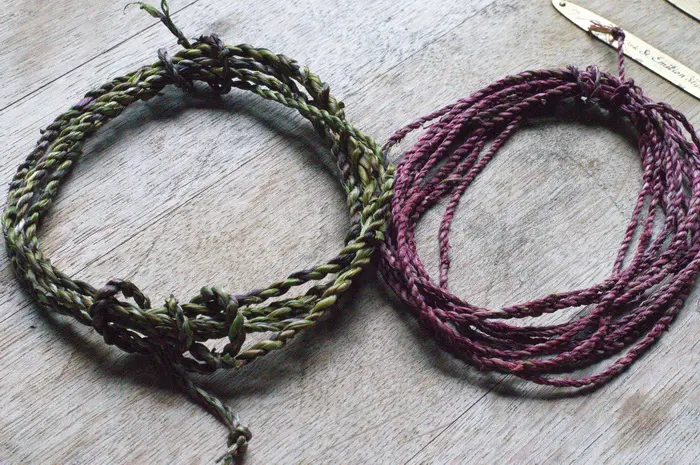Welcome to Herb Camp 2020!
In this second of three weeks of herb camp, the theme is “What do you have in your hand?” What do you have that is growing around you, that you need to heal or to inspire?
In today’s Herb Camp Challenge we’re going to use the materials you have in your garden to make cordage. You can make cordage out of a number of natural materials that have long, fibrous strands made of lignin.
A few materials you might have in the garden right now, that are suitable for cordage:
- Daylily leaves
- Dandelion stems
- Rhubarb peels
- Yucca leaves
- Bulrush or cattail leaves
- Cedar bark (inner bark)
- Stinging nettle
- Linden inner bark
- Willow inner bark
- Linen fibers
In this lesson I’m using rhubarb peels, because they are easy to find, but you can use this technique for any of the fibers I mention above, plus many others that you find in the garden or in the hedgerows near your home.
It is important to dry the fibers first, and then dampen them again, lightly, before twisting. In this way your cord will be stronger and more predictable. Drying the fibers removes the starches leaving lignin fiber for twisting.
To peel the rhubarb for cordage:
Use a pairing knife. Lift just the fine peel from the rhubarb stalk and strip it down the length of the rhubarb. Set each strand aside to dry. If you end up with rhubarb flesh attached to the peel, simply scrape the peel lightly with a paring knife to remove this fleshy part.
Dry the stems in an airy basket for a few hours to remove the moisture. Spritz them lightly before twisting the fibers.
Watch this video to learn the technique of making natural cordage
Tips:
- Always dry the fibers before you try to twist them. This removes the starches from the fiber, leaving the lignin.
- Dampen the fibers or dampen your fingers as you twist the fiber. This helps you maintain control of the fibers and lessens the hairiness of the cord.
- Once you have made the cord as long as you want it, finish the cordage with a overhand knot.
- Use a pair of embroidery scissors to clean up the edges of the cordage, removing the ends from the strands that were grafted in.
- Dip the cord in warm water to balance the twist.
- Dry the cord, without stretching it, to maintain the elasticity in the cordage.
Rhubarb cordage is relatively weak. It can be made stronger by repeating the twisting processed using two strands of your already twisted cordage. Twist in the opposite direction to maintain a balanced twist in the plied cordage. The finished plied cordage will be 1/2 as long as your original cordage. Your cordage will be more than double the strength.

l to r: Dandelion cordage, rhubarb cordage.
Use cordage for:
- Gift wrap
- Handles
- Garden ties
- Macrame
- Jewelry
- Basketry
- Weaving
- Garden Art
- Belts
- Bracelets
The red of the rhubarb will not bleed on your hand nor come off onto clothing. It may fade if left in direct sunlight. This red pigment is betalain. Rhubarb is from the same plant family as beets, chard, amaranth, buckwheat, and quinoa.
Show and Tell
Pop over to the Facebook group and show us a photo of your completed cordage. If you are not in the Facebook group, leave a comment on this post.
Did you enjoy working with the plants? What challenges did you have? Did you innovate? How will you use your cordage?
Note: Click the small arrow on the LEFT to go to the previous day’s Herb Camp Challenge. Click the small arrow on the RIGHT to go to the next day’s Herb Camp Challenge.
I love this, and I have rhubarb! the color is really nice. I hope I can figure this out,,,I’ll have to rewatch later and try this.
I will have to remember this for when my grand children are here..
I hesitate to tear into my rhubarb as it is not doing well.
With the frequent wind gusts, I will gather the limbs up and strip the bark to get the fibers.
Thank you Chris and Sarah.
You can use other plant fibers as well as rhubarb, like dandelion stems, cat tail leaves, daylily leaves, iris leaves. You want to let them dry first. Then tear them into strips, and moisten them to get the pliable enough to begin twisting.
Most of the wild plants we have is sage brush.. and lots of it..